Written music specifies to the musician(s):
Which pitches to perform,
When to perform pitches,
How long to sustain each pitch.
Also, written music will usually contain many other details concerning the performance.
PITCH
(Which pitches to perform) notation is vertical (up and down)
TIME
(When to perform pitches) notation is horizontal (left to right)
LENGTH
(How long to sustain each pitch) is indicated within the individual symbol for each pitch.
FRAME \ 1
FRAME (axes) of music.
Equally spaced horizontal lines are shown for visual reference, these horizontal lines help quickly identify PITCH.
These lines appear in groups of five; The five lines chosen depends upon the range of the music to be performed. These five lines and spaces between lines are a stave (or staff). Symbols (clefs, notes, rests and other symbols) appear on the stave.
The position of symbols define TIME and PITCH so the FRAME is not needed. This is a short section of a stave. Staves become longer (horizontally) as needed. Staves are read left to right, then top to bottom.
Treble Clef \ 1
Staves display pitchs in a specific range. Clef signs indicate the range of staves. There are many clefs. This is Treble clef, also called "G" clef.
This is treble clef on a stave, the line for pitch "G (above middle C)" is labeled.
"Middle C" is a standard reference pitch.
This is treble clef on a stave with lines and spaces labeled. The lines and spaces would represent different pitches with other clefs. Notice that 'A' is above 'G'. The only pitch names used are: A,B,C,D,E,F & G.
This keyboard is labeled with the corresponding lines and spaces of the stave in treble clef (all ivory). The keys are arranged in specific, repetitive pattern; Notice there are no ebony keys between 'E' and 'F' or 'B' and 'C'.
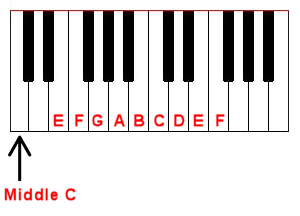
Half Note \ 1
Notes represent specific pitches on staves. This particular note is called a half note. Each kind of note is represented by it's own specific symbol. The half note, like all other kinds of notes (except the whole note), has at least two parts; the head and the stem (some also have flags). In this example the stem rises vertically from the head on the right side. Sometimes the stem descends vertically on the left, depending upon context.
This is a half note on a stave in treble clef representing "G (above middle C)".
This is a half note on a stave in treble clef representing "F (above middle C)".
This is a half note on a stave in treble clef representing "D (above middle C)". Notice how the stem descends vertically on the left. Notes on the upper half of the often have descending stems.
Ledger Lines \ 1
Ledger lines allow pitches to be represented above or below the lines and spaces of the stave. Ledger lines are slightly longer than the note head width. This is a single ledger line below the stave.
This is two ledger lines below the stave. Notice how they are as evenly spaced as the lines in the stave.
This is a half note representing "middle C".
Accidentals \ 1
#(sharp) and b(flat) symbols directly before notes are called 'accidentals'. Together these two symbols (an accidental and a note) represent pitches produced by ebony keys of a keyboard.
Sharps and flats are also used in key signatures. This is a #(sharp) symbol.
This is a b(flat) symbol.
This is F# treble clef on a stave.
This is F# treble clef on a keyboard.
This is Gb treble clef on a stave, the same pitch as F# (above).
This is Gb treble clef on a keyboard.
This is G# treble clef on a staff.
This is Ab treble clef on a stave, the same pitch as G# (above).
This is 'G#' or 'Ab' on a keyboard
This keyboard is labeled with corresponding accidentals (ebony keys). Which (Sharp '#' or Flat 'b') is used depends upon context.
Bass Clef \ 1
There are many clefs. This is Bass clef, also called "F" clef.
This is bass clef on a stave with lines and spaces labeled.
This keyboard is labeled with the corresponding lines and spaces of the stave in bass clef.

Together, joined by a brace, treble clef and bass clef form the "Grand Staff".
"Middle C" would be represented on the Grand Staff (not shown) with a ledger line (below the treble clef stave / above the bass clef stave)
TIME \ 2
TIME in music uses symbols representing whole units (whole notes and whole rests), and divisions of whole units (half notes, half rests, quarter notes, quarter rests, eighth notes and so on).
Where these notes and rests occur on the stave (horizontally) represents when the notes and rests are to be performed.
The relationship between musical time and conventional time is called tempo.
Tempo describes the speed of the music, often expressed as:
How many units of musical time occur within a specified length of conventional time.
Here is a stave with a time line showing equal and even divisions of whole units of time, represented here by integers (1.2.3.4.5...).
Whole units of time may occur at the rate of just a few per minute (seldom much less than 20) to several per minute (not often more than 60).
However, music is rarely read in whole units, but rather in smaller divisions of whole units.
When whole units are divided, it is into equal and even divisions. 1/2 , 1/4, 1/8, 1/16 etc.
This is a time line showing whole units and divisions of eight (8) equal and even parts.

Musical notation uses measures to assist the reader. The term 'measure' is appropriate, because it measures a specific amount of (musical) TIME.
Measures are separated by measure lines. Measures are also referred to as bars, and measure lines are also referred to as bar lines.
This is a few measures, each of which contain one whole unit of TIME.

Not all measures contain whole units of TIME.
For example, this is a few measures each of which will contain 3/4 of one whole unit of TIME.

Signatures \ 2
The time line does not appear in musical notation. Instead, a time signature is used to define measures.
Time signatures are expressed as fractions. This is the basic form of a time signature.
X
Y
X= How many 'beats' define the length of the measure
Y= Which value is a 'beat'
The top number (X) of the time signature will most often be:
2,3,4,6,9 or 12 - However 1,5,7 and 11 are also used.
Not so common will be numbers higher than 12.
The bottom number (Y) of the time signature (beat) will, with rare exception, be:
2 (one half of one whole unit of time)
or
4 (one quarter of one whole unit of time)
or
8 (one eighth of one whole unit of time)
Time signatures are not always expressed using the "lowest common denominator", a common practice in mathematics.
Which bottom number (2, 4 or 8) is used to represent the beat, significantly effects the notation of the music.
For example: Although 6/8=3/4 is a true mathematical equation, there is an important difference between music written using the time signature 3/4 and music written using the time signature 6/8.
Other examples of time signatures that are mathematical equivalents but are not used interchangeably:
2/4 and 1/2; 4/4 and 2/2; 12/8 and 6/4 and 3/2.
A time signature is said to be established when it is placed at the beginning of a measure.
When a time signature is established the following measures are of the same time signature, until another time signature is established.
This is a stave with five measures of 4/4 TIME. The time signature is established in the first measure. Each measure will contain one whole unit of TIME. This is not necessarily the case with other time signatures; not all measures contain one whole unit of time in other time signatures.
Notes & Rests \ 2
Here are some of the symbols used for notes and rests.
Each of these symbols have a consistent relationship to each other and to time signatures.
Whole Note

Half Note

Quarter Note

|
|
|
|
|
|
|
|
|
|
|
|
|
|
|
|
|
|
Whole Rest
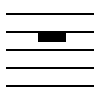
Half Rest

Quarter Rest

Math \ 2
All complete, properly written measures contain notes and rests whose values, when added together equal the time signature.
The "value" of a note or rest is expressed in it's relationship to
a whole unit of time and is contained in it's name.
A whole note and a whole rest have the value "1"; 1 = 1/1 = 1.0
A half note and a half rest have the value 1/2; 1/2 = .5
A quarter note and a quarter note rest: 1/4 = .25
For your convenience, here's a chart that may help with the 'mathematics' associated with this concept:
Four Quarter Values Sum to One Whole Unit:
1/4 + 1/4 + 1/4 + 1/4 = 1
.25 + .25 + .25 + .25 = 1
(four quarter notes or four quarter rests or a combination to equal one whole unit of time)
Two Quarter Values and One Half Value Sum to One Whole Unit:
1/4 + 1/4 + 1/2 = 1
.25 + .25 + .5 = 1
(two quarter notes and one half note or two quarter rests and one half rest or a combination to equal one whole unit of time)
One Quarter Value and One Half Value and One Quarter Sum to One Whole Unit:
1/4 + 1/2 + 1/4 = 1
.25 + .5 + .25 = 1
(one quarter note and one half note and one quarter note or one quarter rest and one half rest and one quarter rest or a combination to equal one whole unit of time)
One Half Value and Two Quarter Values Sum to One Whole Unit:
1/2 + 1/4 + 1/4 = 1
.5 + .25 + .25 = 1
(one half note and two quarter notes or one half rest and two quarter rests or a combination to equal one whole unit of time)
Two Half Values Sum to One Whole Unit:
1/2 + 1/2 = 1
.5 + .5 = 1
(two half notes or two half rests equal one whole unit of time)
1 = 1
1 = 1
This is examples of these symbols in 4/4 time signature. (Normally, a clef would be placed at the beginning of each stave to identify
pitch - not needed for this particular example).
All of the measures in this example contain notes and rests whose values, when added together = 4/4; 4/4 = 1
The first measure of this example contains a whole note. The value of a whole note is 1, which can also be expressed as 1/1 or 1.0; 1/1 = 4/4; 4/4 is the time signature. This measure contains notes and rests whose values, when added together equal the time signature.
The second measure contains two half notes. The value of a half note
is 1/2 which can also be expressed as .5. When the values of the two half notes
are added together, the measure contains the same total amount of time values
as the time signature.
1/2 + 1/2 = .5 +.5 = 1 = 4/4, the time signature.
The third measure contains two quarter notes and one half note.
.25 + .25 + .5 = 1 = 4/4, again the time signature.
The fourth measure: a quarter rest (rest means: perform nothing), half
note and quarter note.
.25 + .5 + .25 = 1 = 4/4
Each value is sustained for the it's complete value.
Examples: A whole note is sustained for 1 whole unit of musical TIME, a half note for 1/2 unit of musical TIME, a quarter note for 1/4 etc..
Beats \ 2
Describing measures in whole units of time (in relationship to a whole note or whole rest) requires numerous decimals or fractions, which becomes tedious. In order to simplify the process, measures are more often described by beats.
Describing by beats means changing the value "1" from one whole unit of musical time to the bottom number of the time signature.
For example: Using the 4/4 time signature, there are four beats to the measure (top number of the time signature) and a quarter value is the beat (bottom number of the time signature).
Here's another look at the previous example:
Describing by the beat, the second measure contains two half notes which, in
4/4 time each have a 'beat value' of 2; together 2 + 2 = 4 beats.
(The second measure contains notes and rests whose beat values, when added together = 4.
There are four beats to the measure.)
The third measure contains two quarter notes and one half note. Described using beats: 1 + 1 + 2 = 4 again, four beats to the measure.
The fourth measure: a quarter rest, half note and quarter note. 1 + 2 + 1 = 4
Here is a chart comparing whole units of time and beats.
In this chart the Quarter and Eighth are used as examples;
Their time signatures have 4 as the bottom number (Quarter)
and
8 as the bottom number (Eighth).
X/4 Time Signature
1 beat = 1/4 unit of Time
Whole unit of Time = 4 beats
Half unit of Time = 2 beats
Quarter unit of Time = 1 beat
Eighth unit of Time = 1/2 beat
X/8 Time Signature
1 beat = 1/8 beats
Whole unit of Time = 8 beats
Half unit of Time = 4 beats
Quarter unit of Time = 2 beats
Eighth unit of Time = 1 beat
This is another example of the notation of TIME, this time signature is 3/4.
All of the measures in this example contain notes whose values, when added together
equal the time signature.
The first measure contains three quarter notes. The quarter value equals 1
beat in 3/4 TIME.
1+1+1=3. Each measure in 3/4 TIME contains 3 beats.
The second measure contains one half note and one quarter note.
2+1=3
The third measure contains one quarter note and one half note.
1+2=3
The fourth and fifth measures introduce two new musical symbols: the
tie and the dot.
How long to sustain each note or rest (Length) is indicated within the individual
symbols for each note or rest.
Each note is sustained for the it's complete value.
A whole note is "held" for four complete beats,
a half note for two, a quarter note for one.
Ties & Dots \ 3
The tie and the dot serve similar functions. They both are used to extend the value of notes; Only Dots are used to extend the value of rests. When a tie or dot is used depends on context.
A tie connects two notes together to tell the reader "sustain this pitch for the length of both of the note values added together". Ties are the only way to indicate that a pitch is to be held across a measure line. Ties are also used within measures.
A dot is placed just to the right of a note (or rest) and tells the reader to "sustain this pitch (or rest) for the length of the note value plus 1/2 the value of the note (or rest)". Because all complete, properly written measures contain notes and rests whose values, when added together, equal the time signature, dots are never used to indicate time values across measure lines.
Measure four in the example contains a half note with a dot.
A half note in 3/4 TIME has the time value of 2 beats. 2 + (2/2) = 2+1=3 there
are three beats to the measure.
This dotted half note is also tied to the dotted half note in the fifth measure. The total length of the pitch is equal to two full measures (in 3/4 time) or 6 beats (1.5 whole units of TIME)
More Notes & Rests \ 3
Here are more of the symbols used for notes and rests.
They represent even smaller subdivisions of a whole unit of time than those already introduced.
Eighth Note

Eighth Rest

|
|
|
|
|
|
|
|
|
|
|
Sixteenth Note

Sixteenth Rest

The eighth note and sixteenth notes are visually different from a quarter note
because of their flags. Their flags are attached to their stems. An eighth note
has one flag, the sixteenth has two.
In order to make the notation easier to read, consecutive notes with flags are
often "beamed" together. Beamed notes are joined by one or more lines at the end
of the stem which replaces the flag(s) of the notes.
A single line connecting two or more notes at the end of the stem indicates
that all of the beamed notes are eighth notes. Here is an example
of two eighth notes beamed together:

A double line connecting two or more notes at the end of the stem indicates
that all of the beamed notes are sixteenth notes. Here is an example
of two sixteenth notes beamed together.

Combinations of single and double beams are also used.
Triplets \ 3
The triplet is a musical symbol, which alters the time value of notes and rests.
It says to the reader: "fit three time values of these notes and/or rests, into
the same time value of two notes and/or rests".
In order to fit three into two, we divide 2 by 3; 2/3=.66
Each note and/or rest (member of a triplet group) has an value equal to .66 of
it's original value.
Measure one contains one triplet group of three half notes.
In 4/4 time, two half notes equals 4 beats (2+2=4).
Each member of a triplet group has an equivalent beat time value equal to .66
of it's original value.
2 (the original beat value of a half note in 4/4 time) times .66 = 2 X .66 = 1.33
1.33 + 1.33 + 1.33 = 4 beats (rounded to the nearest whole number).
The first two beats of measure two contains one triplet group of three
quarter notes. The third and fourth beat contains two triplet group of three eighth
notes.
((1 X .66) X 3) + ((.5 X .66) X 3) + ((.5 X .66) X 3) = 2+1+1 = 4 beats
Swing \ 3
Swing is a very useful form of "short hand" notation. Swing notation grew out
of early American music and is widely used by jazz musicians. When "Swing" is
indicated, the reader converts the first eighth note/rest (of each quarter note
value) into two tied triplet eighth notes/rests and the second eighth note/rest
into a single eighth note triplet. Only eighth notes (and eighth rests) are read
differently in "swing", all other time values remain unchanged.
Here is a pattern of eighth notes in "swing" and as this pattern would be written
without "swing" indicated. Instead of using two tied eighth note triplets, a
quarter note, which has the same time value as two eighth notes with the triplet
bracket, makes the notation clearer.
Written
Read As
Tempo \ 3
Tempo describes the speed of the music. Sometimes this description is in
very general terms (very fast, slowly, moderate etc.) However, the tempo
is often expressed more explicitly with a simple equation, using a note
and a number.
The note is a representation of a significant division of the measure, usually
the beat of the time signature; the number is the how many of these divisions
occur per minute. The number is often called bpm for 'beats per minute', however,
that is not always exactly correct. The note is not always equivalent to the
"beat" as defined by the time signature.
The basic form of a tempo marking is n=t (n = note ; t = bpm). Here
are some examples of how tempo may be expressed.
As humans we have an inherent ability to identify with even, steady, repetitive
percussive sounds - Pulse;
Some examples of "pulse" in music:
Steps
of a waltz, the bass drum of disco, foot tapping to a march, hand clapping of
a gospel choir.
The pulse of music is reflected in how music is written; Pulse
also significantly influences which time signature is used for a particular
piece of music.
This symbol is often used in place
of the 4/4 time signature.
It is called 'common time'.
|
|
|
|
This symbol is often used in place
of the 2/2 time signature.
It is called 'cut time'.
Manifold \ 4
From a mathematical perspective, these five individual lines of music are exact equivalents - the same melodic line written five different ways - (The bpm tempo numbers have been rounded to whole numbers and rests have been added to complete the last measures as needed).
The musical differences between these methods of notation are reflected by the beat and pulse.
These are only a few ways of writing this line of music; as with all music, there are many others. However, there is always a "best" method, depending on the nature of the composition.
Here are the same examples with pulse indicated (by arrows). Notice how often, but not always, the pulse and the beat of the time signature occur at the same time.
Usually, time signatures X/8 have a pulse (and are counted) in groups of three eighth notes.
Repeats \ 4
Sections of music are often performed more than once. Repeats, D.S., D.C. and CODA symbols are used, mostly in order to save paper (and sometimes
page turning).
Repeat marks appear in pairs (left and right) except when a section of music repeats to the beginning of a piece.
Left repeat mark
Right repeat mark
In this example the two measures in the middle would be performed
again (twice in total).
Repeat marks may also be used with endings. In his example,
the right repeat mark tells the reader to go back and play the second measure
again, then skip to the fourth measure (second ending) and continue.
There are several notation variations using repeat marks and endings.
Sometimes the first ending will also be the second and possibly even the third,
fourth and so on.
Repeated sections (and endings) may contain any amount of measures.
D.C. \ 4
Da capo, abbreviated D.C. means "from the beginning".
D.C. Sections are usually much longer than sections using repeat marks.
In this example the D.C. section is shorter than most.
Da capo is used with "Fine" (which means "end").
D.S. \ 4
Dal segno, abbreviated D.S. means "from the sign" - D.S. sections are used more often than D.C. and are usually much longer than sections than those using repeat marks.
The Dal segno / D.S. sign; At "D.S. al Coda", go
to the sign and perform until the "go to the CODA" symbol.
D.S. is used with CODA - this symbol means "go to the CODA"
(last section)
As with repeats, there are several notation variations using D.S. and CODA. Modern music publishers sometimes invent new and often difficult to understand schemes. It's usually best to carefully review written music containing Repeat marks, D.S., D.C. and CODA symbols before attempting to perform the music.
Intervals \ 4
All musical pitches have the same "distance" to next closest pitch. "C" has exactly the same relationship to the pitch just above it, "C#" (or "Db"), an ebony key on the piano keyboard, as "C#" has to the next pitch, "D".
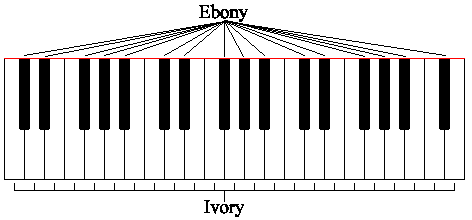
Shown in these examples are two notes appearing at the same point in time (called an interval).
There are no pitches between E and F

There are no pitches between B and C

There are no pitches between F and Gb

G# (or Ab) is the only pitch between G and A
 D# (or Eb) is the only pitch between D and E
D# (or Eb) is the only pitch between D and E

F is the only pitch between E and F#

G# (or Ab) and A are the two pitches between G and Bb

F and F# (or Gb) are the two pitches between E and G

B and C are the two pitches between Bb and Db

Here are more examples, with larger intervals. Because these staves have a Brace (connected together with a line) they are to be performed at the same time.
There are 6 pitches between A and E

There are 9 pitches between F and Eb

There are 16 pitches between G and C
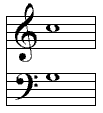
There are 6 pitches between Gb and Db
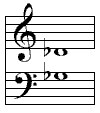
There are 9 pitches between A and G

There are 16 pitches between F and Bb
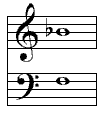
There are 6 pitches between B and F#
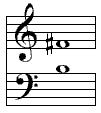
There are 9 pitches between Bb and Ab
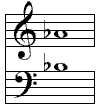
There are 16 pitches between D and G

Scales \ 4
These notes are not shown as intervals (it would be difficult to read all of these notes if they were placed one above the other), However the relationship between each note is important. The pitches these notes represent, in this order, are collectively called a "C Major Scale". On a piano keyboard, all of the pitches are performed with ivory keys. The scale begins and ends on C. There is one pitch between each note except for E to F and B to C. E is the third note in the scale, F is the fourth; B is the 7th note in the scale and C is the Eighth.

The pitches these notes represent, in this order, are collectively called a "G Major Scale". The scale begins and ends on G. There is one pitch between each note except for B to C and F# to G. B is the third note in the scale, C is the fourth; F# is the 7th note in the scale and G is the Eighth.

The pitches these notes represent, in this order, are collectively called a "F Major Scale". The scale begins and ends on F. There is one pitch between each note except for A to Bb and E to F. A is the third note in the scale, Bb is the fourth; E is the 7th note in the scale and F is the Eighth.

All of the notes in each of these scales (above) have the same relationship to each other. Other Major Scales have the same relationship between pitches found in the "C Major scale", the "G Major scale" and the "F Major Scale".
With few exceptions, a piece of music, or a section of a piece of music, is said to be in "C Major" when most and sometimes all of the notes are contained in (from) a C Major scale. Often, most of the notes in a piece of music are better described as being from some other scale.
All other major scales except "C Major" have pitches which are produced on a piano keyboard with ebony keys. Sharps and Flats are used to indicate these pitches. As shown in the previous examples: "G Major" has a sharp which is used in front of the F; "F Major" has a flat is which is used in front of the B.
Keys \ 4
Writing the Flats and Sharps contained in scales other than "C Major"
can and is best avoided by using key signatures.
Key signatures tell the reader to always consider specific pitches
to be Flats or Sharps unless otherwise indicated.
A key signatures is "established" where it is placed (usually at the beginning of a measure, but not always)
When a key signature is established, the following measures are of the same key signature (or just "key"), until another key signature is established.
Key signatures (Except for C Major) appear as sharps or flats at the beginning of each stave. These sharps and flats are placed on the staff in a specific order. Here are the Major key signatures as they appear in treble clef:
 |
C |  |
C |
 |
G |  |
F |
 |
D |  |
B Flat |
 |
A |  |
E Flat |
 |
E |  |
A Flat |
 |
B |  |
D Flat |
 |
F Sharp |  |
G Flat |
 |
C Sharp |  |
C Flat |
Notice how "F Sharp" and "G Flat" indicate the same pitches. Also "B" and "C Flat" / "C Sharp" and "Db".